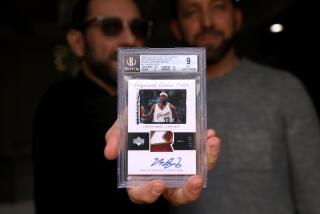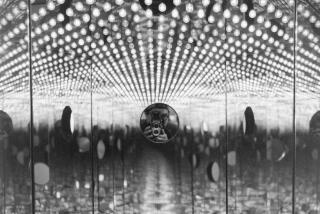Seasoned greetings
Judie Clark openly admits she was addicted: “I went nuts. I’d buy at night from dealers in alleys and parking lots.” The object of her desire? Postcards.
“I’d eat, breathe and sleep obsessed by Disneyland postcards,” she says.
From the day she decided to collect every Disneyland postcard, Clark says she was on the hunt all the time for the cards at swap meets and flea markets, then spending eight hours a day on EBay. “I’d run around in 100-degree heat to get a card stamped in 10 places just to get a free Disneyland promotional postcard. They’re very collectible,” she says.
In the sometimes obsessional world of postcard collecting, such passion is not unusual. Postcards cover all subjects, from outhouses to ostriches, but most postcard enthusiasts collect subjects that are close to their hearts. Clark loves Disneyland postcards because she loves the amusement park. When she and her husband moved from Santa Monica to Long Beach she was close enough to drive to the park after work and went up to 200 times a year. “
After a year and a half of compulsive collecting, her obsession abated when she hit 3,000 cards. She left Disneyland behind and moved on to collecting cards of Santa Monica and Los Angeles County. Clark, the president of the Torrance South Bay Postcard Club, estimates her complete collection numbers 6,000. Her obsession is abated, but not over. “Now I just check EBay for about 10 minutes a day.”
Clark is part of the growing world of collectible postcards. A card that 20 years ago sold for $5 can go for $50 now. Clark regrets passing on a Disneyland postcard she saw in a mall a couple of years ago. “I always paid a dime and a quarter for cards. I thought $3 was a lot. I shouldn’t have thought twice about it, those cards were rare and are worth much more now.” That card now sells for more than $100.
Earlier this month Pasadena hosted Hal Lutsky’s Postcard and Paper show, which is both the oldest (30 years) and one of the largest (90 vendors) in the West. Postcard shows have become plentiful; it’s a popular hobby and most states have several shows a month. “It’s just a great, very affordable hobby,” says Lutsky, who started out in coins before moving to postcards.
First, a little postcard history: Until 1898, only the U.S. government was allowed to produce mailing cards, then known as postal cards. In 1898 postage was reduced from 2 cents to a penny, but the backs of cards were only allowed to have the name of the addressee -- no message was allowed or the sender had to pay the 2-cent letter rate. It took an act of Congress in 1907 to be able to write on the back of a postcard and the era of divided-back cards -- address on one side, message on the other -- began what is considered the golden age of postcards when millions were made, mailed and saved.
“If you were sending out 50 Christmas greetings, you’d save a penny on postage using a postcard versus a letter or enveloped card. That 50 cents fed your family Christmas dinner,” says James Stearns, a postcard dealer and postal history expert.
The majority of images were in color, many of them beautifully printed in Germany -- which almost killed the craze when World War I broke out, making German cards impossible to get. American printers took over the production and the boom continued. Linen paper and chrome images became popular in the coming years but cards from the first 20 years of the last century still make up the majority of vintage cards collected.
The e-mail of its day
The postcard was the e-mail equivalent of the turn of the last century. In most large cities there were two mail deliveries a day. In 1907 you could post a card in the city at 9 a.m. asking your wife in the suburbs to pick you up at the train station at 6 p.m. and she’d have the card by noon.
And, if you wanted to attach an image to your postal “e-mail,” as early as 1904 film dropped off at the local drugstore could come back as prints with postcard backs ready for mailing. This was a good way to get reprint business and put the images into circulation for more people to see. Until a decade ago, real-photo cards were disdained by postcard collectors but now they go for top dollar. Two real-photo Prohibition cards were on sale at the Pasadena show for $750 a piece.
Joel Wayne collects only real-photo Americana postcards from 1900 to 1935. “I am an art director by trade,” says Wayne, who heads advertising for Warner Bros. Pictures. “I ran an advertising agency in New York and worked with great photographers. So many of the postcard photographs are extraordinarily fabulous. I love them both as art and history.”
Wayne and his son Douglas started collecting postcards when the latter was 14. Now 38, Douglas specializes in New York City cards and had a booth at the Pasadena show. He’ll do three more this year as a dealer and attend a few with his father in Kansas, Arizona and Chicago, as a collector.
‘The thrill of the hunt’
Some dealers feel that EBay has damaged attendance at shows. “EBay has changed the hobby for better and for worse,” says Douglas Wayne. “It’s the thrill of the hunt that keeps collectors going and there are cards on EBay that have never been seen before. It’s like a postcard show every hour of the day.”
EBay averages about 160,000 postcard listings at any one time on every subject imaginable. The largest online auction site, EBay started as the No. 1 place to buy and sell collectibles and EBay spokesperson Hani Durzy says it still is. “Billions of dollars in collectibles are traded every year on EBay and the number of postcard auctions are going up every year. Postcards are very popular.”
Some postcard subjects are hotter than others. In 2003, according to Durzy, postcards with royalty and animal themes, and artist-signed cards all increased more than 40% in listings over the previous year. Some of the highest postcard sales ever on EBay were for an 1897 Hawaii pioneer postcard with hula dancers which sold for $1,085 and a signed photo postcard of the composer Tchaikovsky for $1,400. But the majority of auctions listed are for cards under $10.
It isn’t always the search for the killer card that motivates collectors. Many just love the memories postcards hold. For example, 73-year-old Shirley Pollak of Albany, Ore., has been collecting postcards for 50 years. Pollak says she has her whole life recorded in postcard photos taken by family members. “The church where I was baptized, my school,” she recalls. “Everything.”
When she remarried a few years ago she was sure her postcard dealing days were over and so she sold her collection a month before the wedding without consulting her fiancee, Henry. But the hiatus lasted only five months. At a recent postcard show, a friend offered to sell her his booth.
“I approached Henry and asked, ‘Can I have $30,000 to buy postcards?’ He said, ‘Sure, if that’s what you want.’ ” The two now share postcard selling and collecting. It certainly keeps them busy -- they’ll do four shows in 23 days this month alone.
www.postcardcollector.com has information on upcoming postcard shows in Southern California.


